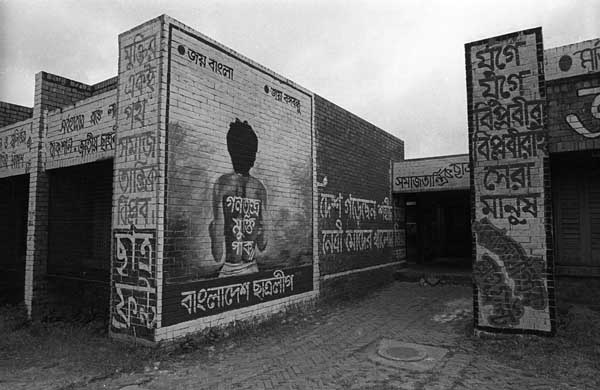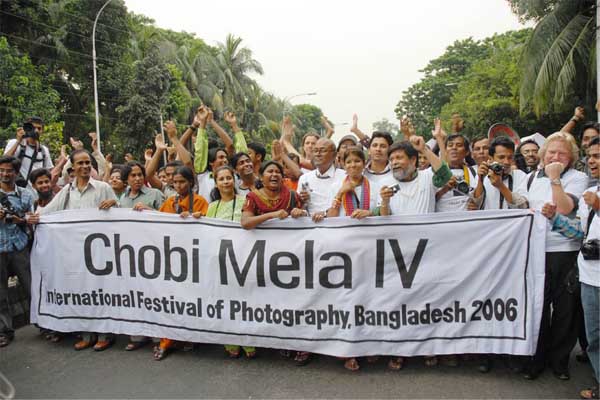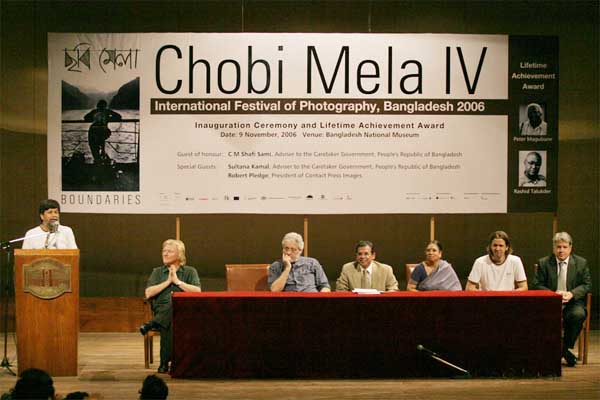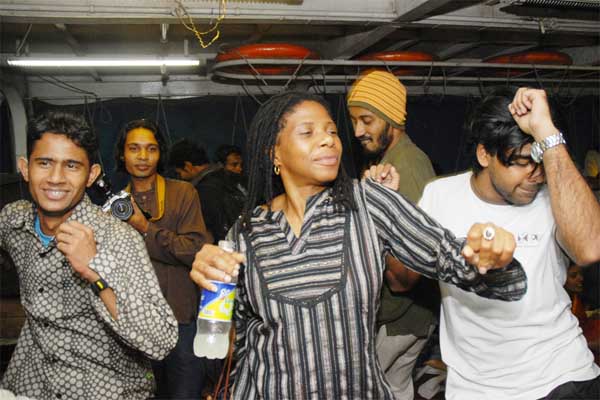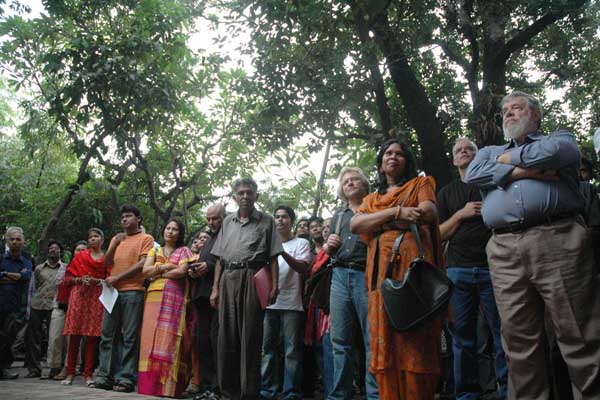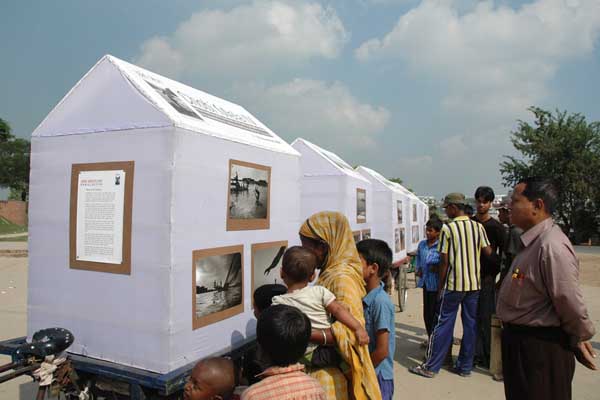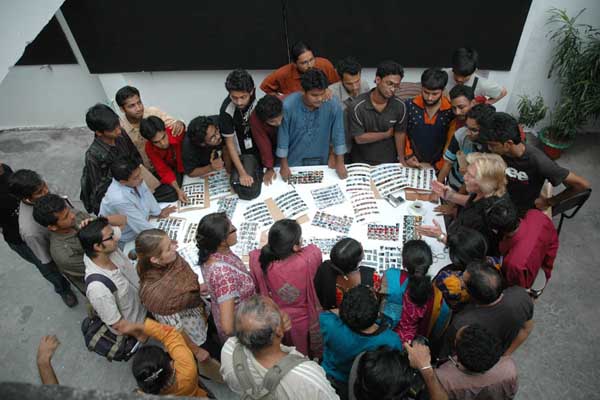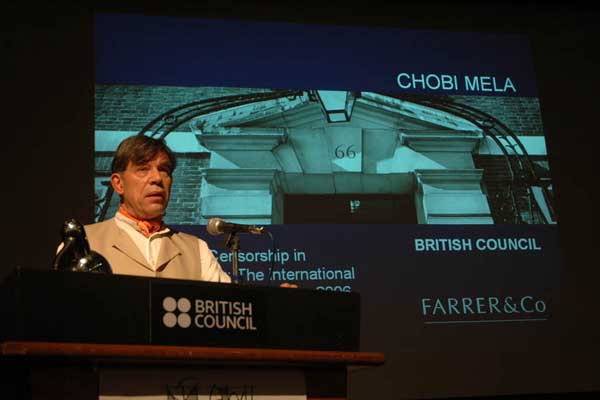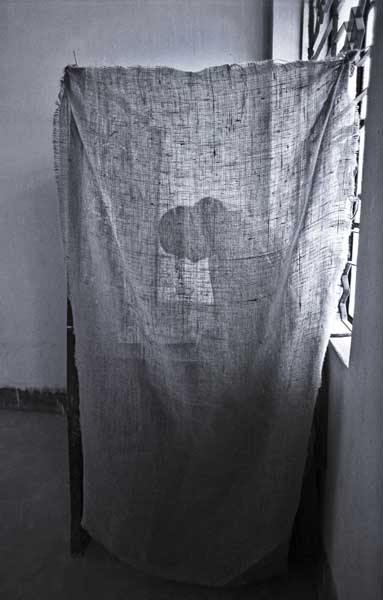![]()
It was 1985, when Jun Jun and I came over for our first trip to Nepal. I had nearly died of hypothermia in our trip to the Everest Base Camp, and Jun and a Japanese explorer had saved my life. My subsequent trips to Nepal have been marked by other drama. As I left for the airport yesterday, Navaraj, the tutor at Pathshala from Kathmandu reminded me that I was going to a new Nepal, one no longer under the rule of the king. Sapna, the human rights lawyer we interviewed in Kathmandu today, remarked wryly, that it was a Nepal ruled by many kings. With the Moaists now in government, one hopes that at the least the violence will go down. Too many lives have been lost.
The killings and disappearances in Nandigram in the largest democracy in the world, and the recent killing of the Adivashi Garo activist Choles Ritchil in the most brutal manner imaginable – ?Choles?s two eyes plucked, testicles removed, anus mutilated, two hand palms smashed , nails of 3 fingers of the right hand removed, left hand thump finger nail removed, two palms had holes, upper right hand had severe wound, several blood stains on the back part of the body, in both thighs middle part there had been two holes, back part of the body had several black marks, several deep marks of wounds on both lower legs, there had been black marks on feet, no nail on thump of right foot, all fingers of two hands were broken.? – by the much lauded new regime in Bangladesh are worrying signs. With conventional media under threat, bloggers become the lonely and marked whistle blowers.
Majority world photographer and All Roads winner from Guatemala Sandra Sebastian is one of many activists in search for solutions.

I couldn?t believe that passers-by weren?t killed when a shooting occurred between drug traffickers on a busy day in one of the principal avenues in Guatemala City. Two presumed drug traffickers were murdered in their car, which had lots of AK-47 bullet-holes. There were hundreds of bullet-holes all around the avenue. The walls of a school and a bus stop where many people usually sat, were also riddled. Unfortunately two men died, but it could have been a massacre. How many people have to be killed before something is done?
I wasn?t the only astonished person. I took the picture because I want to document and leave a testimony of the time I live in and show the danger that ordinary people face. In the last year alone (2005) more than 5,000 people were killed in street violence in a country of 13 million people. The reasons? Delinquency, organized crime, drug trafficking, poverty, broken homes. I want to talk of the inefficient justice system and the impunity with which some operate. I want to point to the consequences, and hope people can understand and search for solutions.
Category: culture
1971 as I saw it
![]()
Thirty five year ago, even longer perhaps, just a camera in hand, they had gone out to bring back a fragment of living history. Today, those photographs join them in protest. Peering through the crisp pages of the newly printed history books, they remind us, “No, that wasn’t the way it was. I know. I bear witness.”
The black and white 120 negatives, carefully wrapped in flimsy polythene, stashed away in a damp gamcha, have almost faded. The emulsion eaten away by fungus, scratched a hundred times in their tortuous journey, yellowed with age, they bear little resemblance to the shiny negatives in the modern archives of big name agencies. They too are war weary, bloodied in battle.
So many have sweet talked these negatives away. The government, the intellectuals, the publishers, so many. Some never came back. No one offered a sheet of black and white paper in return. Few gave credits. The ones who risked their lives to preserve the memories of our language movement, have never been remembered in the awards given that day.
35 years ago, they fought for freedom. They didn’t all carry guns, some made bread, some gave shelter, some took photographs.
(c) Abdul Hamid Raihan
Abdul Hamid Raihan is one such photographer. A.S.M. Rezaur Rahman came upon him through a small interview on television. Unlike many other photographers, Raihan had preserved his negatives. And unlike many researchers, Reza had doggedly pursued. The exhibition, “1971, as I saw it” is not a record of momentous events, but a rare glimpse of what everyday people might have witnessed under occupation and through victory. press-release-english-bangla.doc
——
Autograph ABP presents: The John La Rose Talk Series
Documentary Photography & Social Change: Mark Sealy in conversation with Lyndall Stein and Shahidul Alam at Amnesty International UK
Amnesty International UK
The Human Rights Action Centre
17 – 25 New Inn Yard
London EC2A 3EA
6.30pm – 8.00pm 29th March 2007, Phone +44(0)20 7033 1500, Nearest Tube: Old Street, Moorgate & Liverpool Street
In an age where our daily lives have been saturated by images of globalization there has been a revolt by NGOs and arts organisations who are beginning to forge links and alliances to explore new ways of using visual culture to discuss issues that address a human rights agenda in the 21st century. It is in this context that Mark Sealy the Director of Autograph ABP will explore a conversation that looks specifically at the role photography has played in helping to bring global human rights issues to a wider constituency.
A student screams out to friends from a police van at Jagannath Hall, Dhaka University, after a police raid. 31 January 1996. (c) Shahidul Alam/Drik
—-
Meanwhile Bangladeshi photographers shine at the 3rd China International Press Photo (CHIPP) Contest held in Shanghai from March 21 to 25, 2007


Former Pathshala student Munem Wasif, now working with www.driknews.com wins the bronze prize in the Daily Life category with a powerful piece showing modern forms of slavery, through his story on the workers in the tea gardens of Bangladesh.
Former student of Pathshala and University of Bolton and currently tutor of Pathshala – Andrew Biraj – wins the bronze prize in the Topical News category with his timely piece about the attempts by multinational companies to take over land of indigenous communities,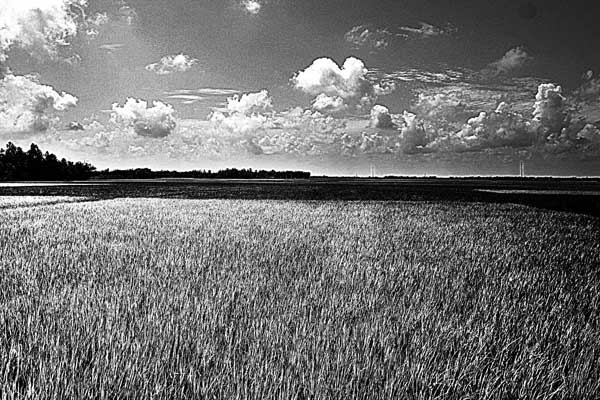



while photographer Shafiqul Islam wins an honourable mention in the same category for his piece on police brutality against women. Biraj and Shafiq are both contributing photographers of DrikNews.

Meanwhile on it’s independence day, Bangladesh moves towards the final eight in the ICC World Cup! However, while we celebrate these wins and the recent arrests of godfathers and the ongoing cleaning up operations, the new laws curbing public freedom continues to worry. The death of Garo activist Cholesh Ritchil (http://www.drishtipat.org/blog/2007/03/19/urgent-modhupur-eco-park-activist-killed-2/) in the hands of ‘Joint Forces’ makes us fearful of the consequences of absolute power.
Justice for Nurjahan
Photographs Shahidul Alam
Text Rahnuma Ahmed
It was reported in the papers as suicide. On 10 January 1993 Nurjahan, a woman in her twenties from a struggling peasant household from the Maulvi Bazar district of north-east Bangladesh, was found dead from poisoning at her parents’ house in the village of Chattokchara.
Nurjahan Begum, 7th among 9 daughters, had been married five years before the incident. However, her husband abandoned her and she returned home to live with her parents. Later, her parents arranged another marriage for her, but since polyandry is forbidden by Muslim law, it was necessary to discover whether her first marriage had been properly dissolved. Nujahan’s father consulted the village imam (religious leader), who declared that she was free to marry. However, he revoked this later and claimed that the marriage was illegal because the first still stood. A shalish (village council for settling disputes and trying offending villagers) met to judge whether Nurjahan and any of her family members had broken the law. The shalish found Nujahan guilty of fornication, on the grounds that she was still married to her first husband; after debating the punishment, it decided that 101 pebbles should be thrown at Nurjahan and her second husband.
Pebbles were preferred to stones since the intention, reportedly, was to shame the couple rather than hurt or kill them. Nurjahan’s parents were also to be punished; the shalish decreed that they should be beaten with a broom. Nurjahan was made to stand in a hole that was then filled, half burying her, to receive her punishment. As she did so a member of the shalish approached her and castigated her for the shame she had brought on her family. She was not fit to live and should kill herself. Nurjahan was found dead the next day.
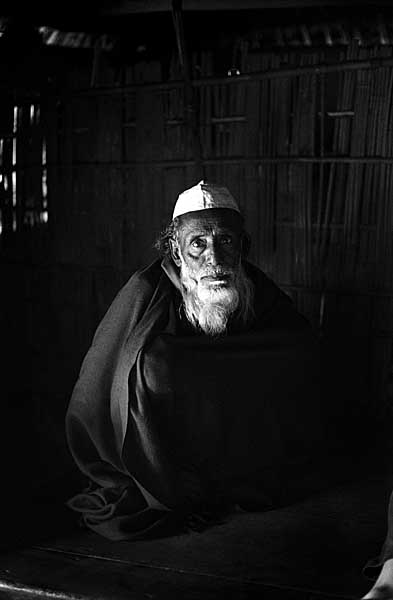
Nurjahan’s father
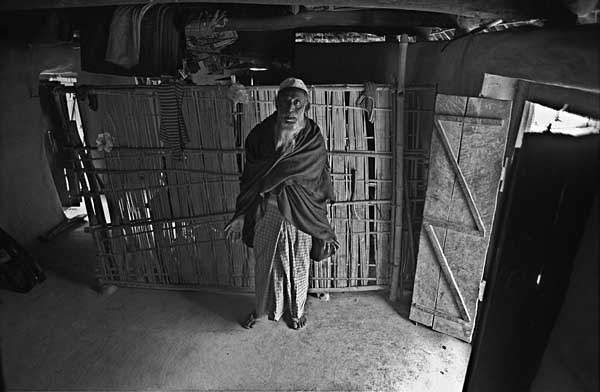
Nurjahan’s father: “This is where I found my daughter’s body.”
The affair was reported in a local newspaper. A campaign was launched by women’s groups to demand a criminal investigation into the circumstances of the death. Public outrage and the success of the campaign turned it into a landmark case;
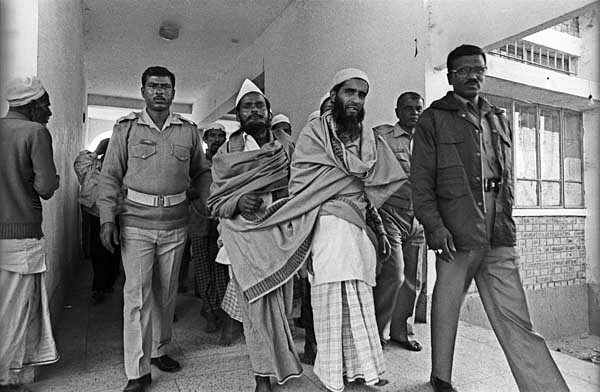
Accused being taken to Moulvibazar court
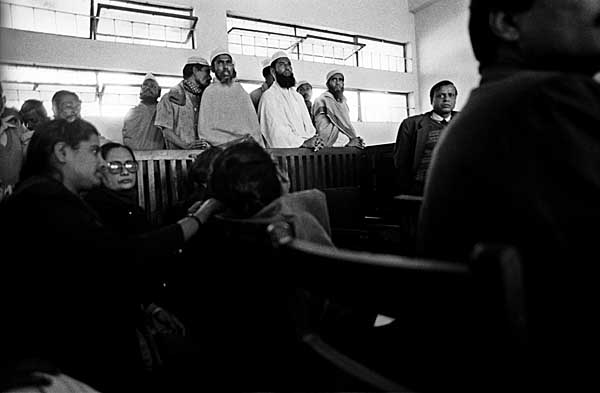
The accused in Moulvibazar court
proceedings were brought against the imam and the members of the shalish only a year after Nurjahan’s death. He and eight others were subsequently found guilty of abetting the suicide and received the maximum possible penalty of seven years’ hard labour. The village shordar (leader) died of illness while in custody.
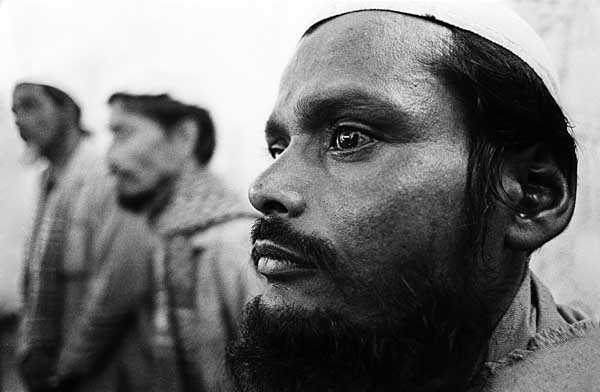
The accused in court jail.
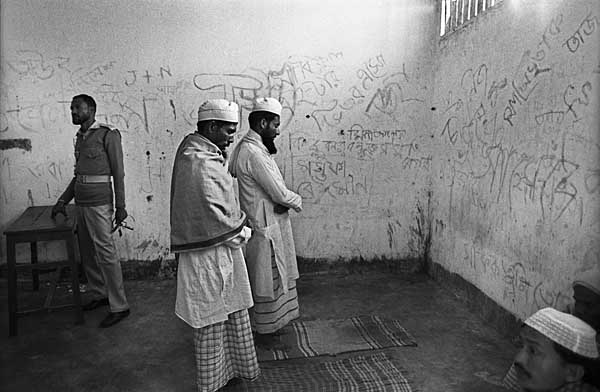
Imam leading prayers in court jail.
Nurjahan’s father believes that his family was made to suffer because of a long-standing enmity between him and the shordar. A female relative of the shordar spoke ill of Nurjahan. “She was a bad woman,” she said. “She would be seen working outside her home.” A rickshaw-puller from Chattokchara came to her defence. “Yes, she worked outside her home. But what other choice did they have?” he argued. “The family is poor.” But he did harbour some doubts. “Why was the wedding held secretly? Why were we not invited?”
Nurjahan’s death has raised many issues for the Bangladeshi women’s movement. Her tragedy has highlighted the manifold forms of women’s subordination within rnarriage, the family and within the community. First, Nurjahan was abandoned by her husband. Then it was the imam who held the knowledge about whether she was free to marry, and he misled her. Finally, it was the members of the shalish, all men, who judged and punished her.
Shalishes have been known to fine and discipline members of the community; at the same time, there are also instances of women disobeying or ignoring and, in some cases, challenging shalish pronouncements. Nujahan’s death has given rise to questions about the sphere of jurisdiction of the shalish, which is a community body with no legal status.
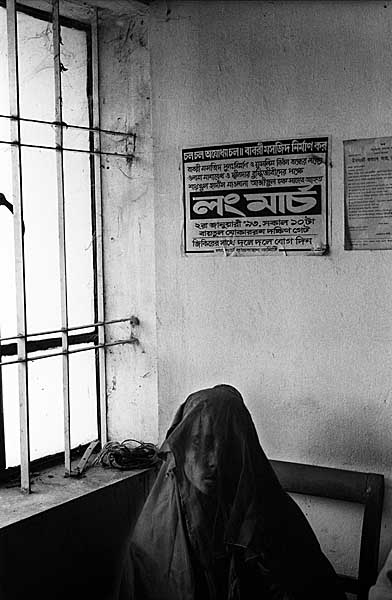
Wife of one of the accused, waiting outside courtroom.
There are few reminders of Nurjahan herself. Of her belongings, a torn corner of a shari, and a shawl she was wearing when she died, have been put aside. Her few remaining clothes were being worn by women in her family. Her only other belongings, a pot and two pans. were being used by her mother.
The family has no photographs. Her grave, like that of the shordar is a small clearing on a hillock near the village, scarcely recognisable as such. The district commissioner promised that the site will be named “Nurjahan tila”.
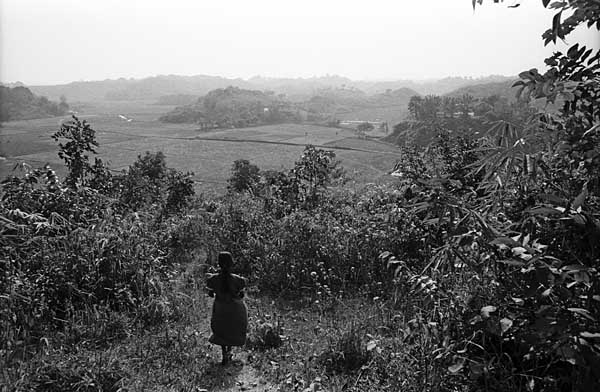
Nurjahan’s sister at her grave.
The government, in turn, announced that a road would soon be built to Chattokchara. However, in all likelihood, this is probably more significant for visiting journalists and officials, than for her family.
The Month of Victory
![]()

14th December 1971. The stark dismembered face stared from the bricks in the Rayerbazar graveyard. It was a last ditch attempt by an occupation army to leave a nation they had been unable to subdue, crippled intellectually and culturally. Rashid Talukder’s iconic image was one of numerous outstanding photographs taken by Bangladesh’s best known photojournalist. The lifetime achievement award given to him was long overdue. Rashid Bhai joins other Bangladeshi photographers featured in the Festival of Photography in Asia Chobi Mela IV, whose images grace the much awaited Drik Calendar 2007.
Meanwhile a self appointed head of caretaker government chooses the month of our victory, to call in the military against the wishes of his own cabinet. Kudos to the caretaker advisers who chose to resign rather than going against the interests of the nation. Where ministers have shamelessly stayed on despite blatant exposures of corruption and malpractice, it is a rare example of self-respect.
The Drik calendar 2007 is in the press and is out next week when it will also be available on our website: http://www.drik.net/html/calendar.htm and in our online shopping mall: http://kiosk.mdlf.org/estore/publisher?id=21

Autumn was unkind, rude and remorseful
Spring become unmerciful, rude and murderous
Butterflies don?t die, they don?t live either
Photo: Momena Jalil

Dried Kash flowers at the bank of the Old Brahmaputra. “When I had my legs I could cross the river in one go.” Rajib. Bangladesh/Photo: Saiful Huq Omi.
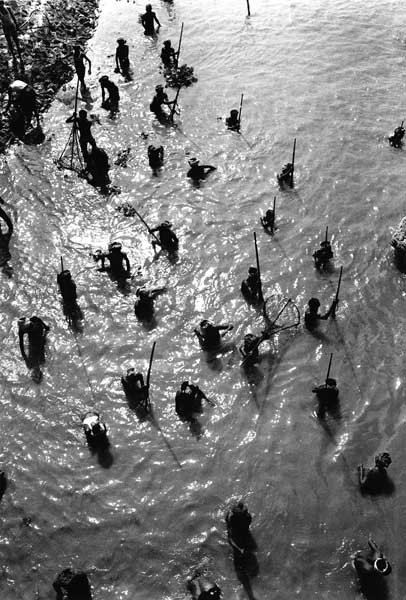
People fishing in a group using traditional techniques. The fishing usually takes place in the dry winter season. Wetlands of Bangladesh/Photo:Rashid Talukder.
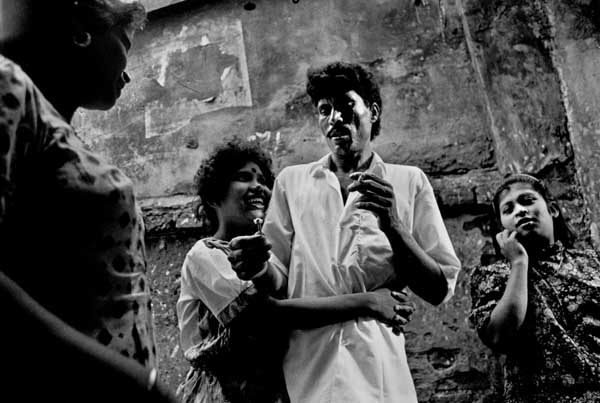
Enticing a prospective client. With roughly 25 customers needed for daily upkeep, competition is intense. Kandupatti brothel, Dhaka. Bangladesh/Photo: Shehzad Noorani.

Every morning After Fazr, Keramat Ali sat here. His work ended at around 10 pm. After 22 years of service, he went back to his home town and his family. No pension and no savings/Photo: Syed Mahfuz Ali
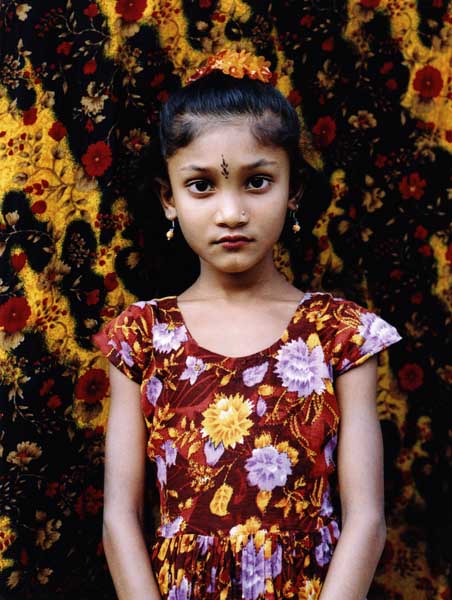
?Mama, take my picture,? my niece Pinki asked me. It was already nearing dusk. I held my breath with the aperture open just enough, and pressed the shutter/Photo: Sheikh Motiar Rahman

Sheep head for shelter at the onset of a storm in the Himalayan range in the Yarlung Valley. Eastern Tibet. China/Photo: Shahidul Alam

She migrated from the Northern district to Dhaka for livelihood. As a sand worker at Gabtoli, she works dawn to dusk for seventy taka. Bangladesh/Photo: Partha Prathim Sadhu

Men saw a large tree trunk in the naked afternoon sun. They don?t pick leaves in the gardens. Kapai Garden, Lashkarpur Tea Estate. Bangladesh/Photo: Munem Wasif

Traders import cows from India prior to the Muslim festival Eid Ul Azha. A cow falls in the water while being unloaded from a boat. Aricha. Bangladesh/Photo: Abir Abdullah

?These are the shacks we live in ? we call them ?Tali? ? there are 1873 families living here at this moment.? Rohinga refugees from Myanmar. Teknaf. Bangladesh/Photo: Mahbub Alam Khan

This is a Road I have been seeing for ages, while I have been happy, sad, upset, romantic, high, low & while growing up. It fills me with memories. They call it the VIP Road/Photo: Gazi Nafis Ahmed (Adnan)
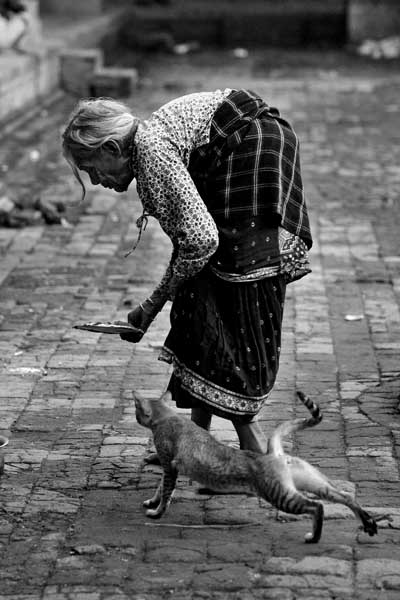
Dipa Thapa, 75, has two pet cats in Pashupati Bridhashram (an Old People?s Home). They are her only friends. Nepal/Shehab Uddin
In the countdown to the election the newly launched DrikNews, promises to challenge the stranglehold of western agencies AP, AFP and Reuters. www.driknews.com is the site to watch.
14th December 2006. Amsterdam
Judge on the docks
![]()

?Come out we won’t shoot?, they had yelled out over the megaphone. Not the most alluring of invitations, particularly when it is from a police van surrounding your flat at midnight. They had thought we were hiding someone and after searching our rooftop had come into our flat. As they left, I had gone out to take pictures from our verandah. Rahnuma had turned up the television volume to hide the sound of the shutter on my Nikon 501, but it still seemed to make a very loud click. Luckily, I wasn?t noticed. It was the 2nd December 1990. Ershad?s autocratic government was feeling the heat. 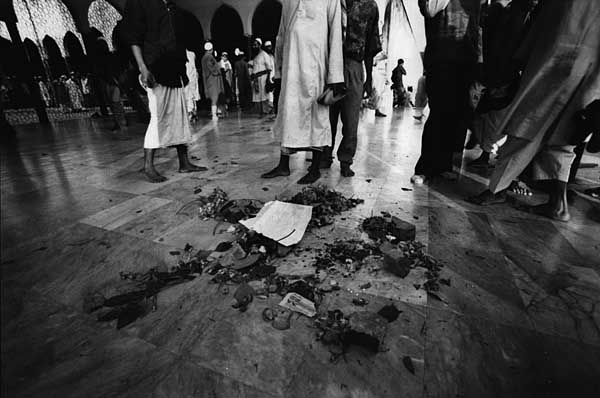
Two days earlier, after the Friday prayers, they had opened fire on the Baitul Mukarram mosque killing a man.
Lawyers had played an important role in our democracy movement. They had upheld writ petitions against the government, and when the government tried to flex its muscles, they came out in protest, united in their stand.

On this day, exactly sixteen years ago, barrister Shahjahan, Sarah Hossain and other lawyers were meant to meet at Drik. We were monitoring the government action, and were ourselves under scrutiny. My colleagues had warned me that plain clothed detectives were looking for me at the office. The detectives seemed to know we lived in Lalmatia, and my colleagues suggested that we stay elsewhere that night. Ma (Rahnuma?s mum), Rahnuma, Tehmina (a lawyer friend of ours) and I went over to Saif and Rini?s flat in Dhanmondi Rd 8. This was not the time for taking chances. The media too had played their role. When censorship became intolerable, they refused to publish. It was that night that Ershad had announced on television that he was going to step down. People were rejoicing in the streets. The following morning the first newspaper was out.
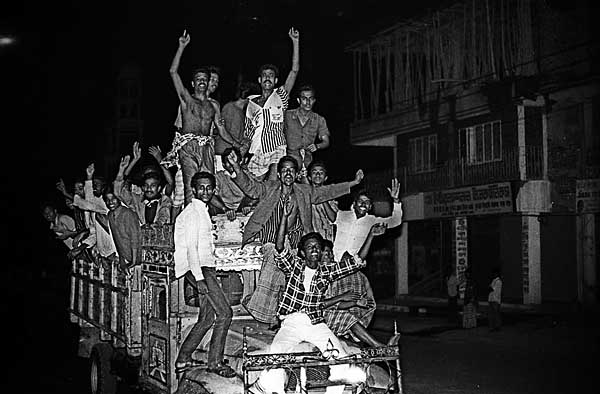

We all went out into the streets. Altaf on his motorbike, me on my bicycle, and the others in whatever transport they could find.

A little girl walked down Mirpur road with a bouquet of flowers in her hand. She too was celebrating the return of democracy. People were dancing in the streets. In Paltan, too often the scene of violence, people gathered in ones and twos.

Men and women in their sleeping clothes, some with children, gathered in the winter night. Chatpati wallas sensing a business opportunity appeared out of the fog. At about 1:30 am Shimul Billa, Bangladesh’s Shirley Temple, sang out ?Bichar poti tomar bichar korbe jara, aj jegeche ei jonota?.

The song ?O judge, the people have risen, it is now the day of your judgement?, was strangely prophetic.
And now in 2006, the chief justice of the supreme court intervenes to prevent a decision
going against a political party, lawyers ransack the court, a president with zero credibility heads a caretaker government, and of all people, Ershad himself is in the streets, demanding the removal of the current president, while Moudud, the chameleon survivor, then Ershad’s right hand man, now holds hands with the chief justice.
4th December 2006
Delhi
Taking care of the caretaker
It was a dramatic ending to Robert Pledge?s presentation. Via Topu and Omi, I?d received the news that the military had been called out. Robert wanted to finish the presentation, but once I?d announced the government?s decision, the auditorium of the Goethe Institut quickly emptied out. This particular Chobi Mela IV presentation had come to an abrupt end. It was 1987 revisited.
Noor Hossain had painted on his back ?Let Democracy be Freed? and the police had gunned him down on the 10th November 1987. But the people had taken to the streets and while we were scared the military would come out, there was no stopping us. It had taken three more years of street protests, before the general was forced to step down. The people had won. But then it had been a military general who was ruling the country. This was a civilian caretaker government. The general mistrust of a party in power, had resulted in this unique process in Bangladesh where an interim neutral caretaker government headed by a Chief Adviser (generally the most recently retired Chief Justice) and consisting of other neutral but respected members of the public were entrusted with conducting the elections. Why then the military? Yes, the president was a Bangladesh Nationalist Party (BNP, the largest party in the outgoing coalition government) appointee, there are ten advisors who are meant to be neutral.
A free and fair election hasn?t yielded the electoral democracy we had hoped for. After each term, the people have voted out the party in power, only to be rebuffed by a political system that has never had the interest of the people on their agenda. Still, the elections were held, and despite the fact that there had been one rigged election in 1996 (rejected and held again under a neutral caretaker government), an electoral process of democratisation, was slowly developing.
This time however, the total disregard for the electoral process has created a sham, and the three key people in this electoral process, the president, the chief adviser, and the chief election commissioner (CEC), are colluding against the people. The first two, being represented by the same person, was a BNP appointee. He also happens to be the head of the military. The CEC, now a cartoon character, had also been appointed by the BNP while it was in power. Coupled with a clearly flawed voters list, this has removed any hope of a free and fair election. Can the caretaker government genuinely conduct a fair election? I believe it still can, if given the chance, despite the president?s lack of credibility. But for that to happen, the military, the bureaucracy and the police need to remember that it is with the people that their allegiance lies.
However, it does depend upon the removal of the other obstacles. The election commissioner cannot constitutionally be removed, and his removal is central to the opposition demands. What then can we do? There is only one body higher than the constitution, the people themselves. The advisors need to be empowered if they are to pull off this election. Sandwiched between a partisan executive head and another partisan CEC, the advisers risk becoming irrelevant. The only way this can be checked is if people come out in droves. Not ?hired for the day? supporters but ordinary people committed to civilian rule, and a multi-party system.
It is we the people who need to take to the streets. And it is time we sent out the message to all political parties, that an entire nation cannot be appropriated. They need to be told that we did not liberate our country in vain, and despite the poverty and the hardship that we go through, we will not be cowed down, and will not blindly tow a party line, when the party itself has disengaged from the people. If tomorrow, every woman man and child takes to the street of Bangladesh, there is no power, not the military, not the president, not the advisers, not the CEC, not the BNP and not AL that can stop us.
There is hope yet. The advisers have had the good sense to reverse the home ministry?s unilateral decision to call out the army and the president and chief adviser has been challenged for taking such a step. Whether the advisers can continue to take such bold steps depends on our ability to bolster their nebulous position.
Blockades and hartals do hurt the economy, and ironically, it is the person in the street who is the most vulnerable. But faced with an attempt to take away the only chance she has to exercise her right to elect the government of her choice, she has little option left but to take to the streets. As the world is finding out, in Iraq, in Afghanistan, and wherever else there is conflict, a military victory is never a victory. If the anger of the people is to be quelled, then the underlying causes of discontent need to be solved. Flexing the muscles of the military, will only put a lid on the boiling pot, and the longer the lid is pressed down, the bigger will be the eventual explosion. More have died today, and with every death, the flashpoint looms closer.
Chobi Mela IV has continued despite it all. The dancing in the all night boat party,
the heated arguments at every meeting point, the mobile exhibitions, all went on despite the turmoil. The presentations on the night of the 11th, with Yumi Goto, showing work by the children from Bandar Aceh, Neo Ntsoma showing her work on youth culture in South Africa, Chris Rainier showing his long term projects on ?Ancient Marks?, and the deeply personal, but very different accounts of Trent Parke
and Pablo Bartholomew, made one of the most intriguing evenings I can remember. The packed audience that had braved the blockade had perhaps an inkling of what was to come. Morten had a full house for his ?gallery walk? at the Alliance Francaise and Trent?s workshops were packed out. The grand opening was at the National Museum, where we had one fifth of the cabinet opening the show. Kollol gave a passionate rendering of his song ?Boundaries? written especially for the festival. The rickshaw vans designed to take the festival to the public, plied the streets of Old Dhaka, Mirpur and other areas not used to gallery crowds.
The chief guest, adviser C.M. Shafi Sami, the special guests adviser Sultana Kamal and Robert Pledge, photographers Morten Krogvold and Trent Parke and the scholarship recepient Dolly Akhter all spoke eloquently. Little did the audience know about the drama that had taken place the night before. With the museum functionaries doing their best to keep us from putting up the Contact Press Images show (http://www.chobimela.org/contact_press_images.php), we were under pressure, but working all through the night and sleeping on the museum floor, we managed to put the show up on time.
Last night, the empty streets, looked ominous as I dropped off Chulie, Robert and Yang, and people have been dying in the streets.
Since then we have had Morten Krogvold?s passionate presentation at the gallery walk at Alliance, Rupert Grey?s clinical dissection of the law and his dry British humour,
both at the British Council and the Goethe Institut, Saiful Huq Omi?s disturbing but powerful images of political violence, Cristobal Trejo?s poetic rendering of an unseen world, Richard Atrero De Guzman?s honest response to difficult questions about representation and my own presentation on natural disasters and their social impact have all been well attended, despite the tension in the desolate Dhaka streets. The evening presentations close tonight with an insightful film by Indian film maker Joshy Joseph, presentations by Norman Leslie and a behind the scenes look by the photographers at the Drik Photo Department, Md. Main Uddin, Shehab Uddin and Amin, Chandan Robert Rebeiro, Imtiaz Mahabub Mumit and Shumon of Pathshala and Mexican exhibitor Cristobal Trejo. The shows go on as they always do at Drik.
In 1991, a woman with her vote had avenged Noor Hossain’s death.
A fortnight ago, the city was in flames, and a stubborn chief election commissioner is stoking the flames again. It is a fire he and his allies will be powerless to stop.
Shahidul Alam
Dhaka
Chobi Mela site
Blog by Australian curator Bec Dean
Short video on Chobi Mela IV
On One Eid Day
Dr A.K.M. Abdus Samad, the director of the mental hospital in Hemayetpur, Pabna, was pragmatic. “An average of 2% of all populations are schizophrenic, and of course there are many other mental ailments. In this country of 130 million, we have one hospital with 400 beds. What do you expect? The government allocation for food is 18 Taka per day (about 45 US cents when we met in 1993). Many mental patients are hyperactive and need more food. A good portion of that 18 Taka goes to the contractor, the remainder has to provide three meals a day. So what can I do? I make sure they get plenty of rice. That way they at least have a full stomach. We have little money for drugs, and virtually no staff for counselling, so we keep them doped. Then they don’t suffer as much.”
The other doctors had a different take. “Pity you’ve come on a Friday they said. On a weekday we could have shown you an electric shock treatment.” It seemed to be a popular ‘treatment’. To the uninitiated like me, the violent convulsions and the near comatose state the patients lay in afterwards didn’t seem to be the way to treat anyone. The care givers differed. The treatment was generally given to suicidal patients they said, and the way they saw it, it was “better than letting them kill themselves.” I didn’t have much of an argument against that one.
I saw the group of visitors come round to the dorms at night and peep through the windows. It was well after visiting hours, but they had paid to get in and have a look at the ‘pagols’ (loonies). On Eid day, many would dress up and come to the peep show. Some patients did get visitors on Eid, a select few even got new clothes or special food, but for most, it was another day of waiting. Another day of hoping that someone close might come and take them away.
In every ward I went, someone would take me aside, and slip a note in my hand. Invariably, scrawled in that note would be an address. “You must take it to them (their relatives). Tell them I’m OK. Tell them to take me away from here.” The first few times I did try and contact those relatives. Some addresses had people who recognised them, most didn’t. None seemed keen on responding. Eventually I gave up, but I would still take the notes. In Hemayetpur, even false hope seemed something worth giving.
—————————-
As another Eid approaches, I remember the child Shoeb Faruquee had photographed in Chittagong. It won him an award at World Press Photo, but I wonder where the child is now.
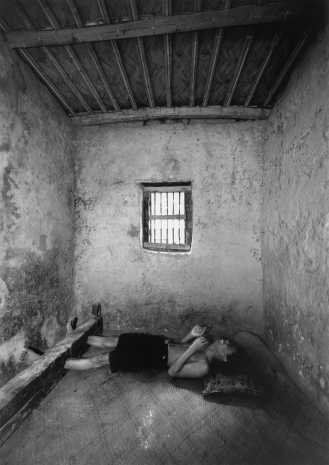
Patient at mental hospital, Bangladesh
? Shoeb Faruquee, Bangladesh, Drik/Majority World
Mohammad Moinuddin had yet another story to tell:
http://www.newint.org/columns/exposure/2006/08/01/md-main-uddin/
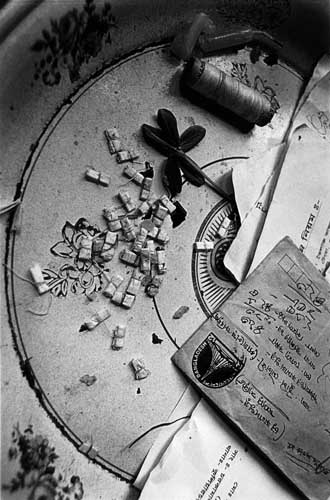 ? Md. Mainuddin, Bangladesh, Drik/Majority World
? Md. Mainuddin, Bangladesh, Drik/Majority World
I was on an assignment at Domra Kanda, an asylum for the mentally ill in Kishoreganj, Bangladesh, where the only medications provided are these ?medallions? filled with spiritual spells and ?blessed water? from traditional spiritual healers. Illiteracy about medical treatments ? particularly those related to mental health issues ? misconceptions and limited health facilities mean that many parents resort to their faith in such medallions and other blessings from spiritual healers. The clinics which provide such traditional solutions do not offer scientific medications of any type and neither are they approved by any health authority. But for many Bangladeshis, faith in traditional healers and their treatments is more powerful, effective and easily available than scientific medication. The parents strongly believe that it is their faith in such spirituality that will cure their child and bring back the long lost peace and happiness to their family.
———————————————————————————————————————————————————
In a world where normality is a virtue, I salute the few individuals who have chosen to be different.
Shahidul Alam
23rd October 2006. Dhaka
ps: Apologies to ZAK on my spelling of Eid: http://www.kidvai.com/zak/2005/11/its-that-time-of-year-again.html
These strangers are family now
PHOTOS and TEXT by SHEHAB UDDIN
Nepal Times Issue #304 (30 June 06 – 06 July 06)
Most people find shelters for senior citizens depressing and avoid visiting them. But working on this photo feature at the Pashupati Bridhashram over the past six months, I have been inexplicably uplifted. I forget the stress of living in Kathmandu and my homesickness for my native Bangladesh. I feel fortunate that I have a family, as many of the senior citizens once had. But what gives me hope is that even though they have lost families and possessions, they still care. They care for each other and they retain a deep sense of humanity. The story of how they landed up here is almost always the same: in their old age they became a burden on their families who dumped them at Pashupati. For the elderly, it?s sometimes a relief that they are in such a holy place and don?t have to bear the taunts of a home where they are no longer welcome. None of them came here willingly and no one has anywhere to go. The Pashupati Bridhashram is run by the government so its budget is limited, it is congested, short-staffed and shows signs of mismanagement. There are 230 residents, 140 of them women.

GREETING: ?Namaste, aram?? That is how Sankule Lati, 77, greets strangers with a namaste and a quick tilt to her head.

LAUGHING: Til Kumari Khatri, 71, and Yadongba Tamang, 70, laugh and play like children. Til Kumari has been here since 1998. Her daughter-in-law brought her to the shelter one day and left saying: ?I?ll be back soon.? She never came back.

CHANTING: Every morning and evening residents gather for bhajans. Those who can?t walk to the prayer room chant from their own beds.

BATHING: Dhana Kumari Ranabhat, 99, takes a bath with the help of her husband Dil Bahadhur Ranabhat, 90. The couple is lucky, few here still have their spouses. Dhana Kumari was forced here after her husband died but married Dil Bahadhur, a retired soldier.

CHATTING: Tirtha Maya Thapa, 75 and Man Kumari Thapa, 75, sit and chat. Tirtha Maya was so busy taking care of her parents, she never married. But after they died, her relatives evicted her from her house. Man Kumari?s long lost son came and took her home a few months ago.

EATING: Bishnumaya Lati, 72, takes her evening meal with her two favourite dogs in attendance. She lives here with her husband.

COOKING: Kanchi Khatri cooks food in the shelter. She was the maid servant at the home of an astrologer and when she was no longer able to work nine years ago, her employer brought her here.

PRAYING: Laxmi Thapa, 68, prays to a wall full of pictures of the gods. She doesn?t remember where she was born or her family since she was married very young. Laxmi worked as a domestic all her life. Her alcoholic husband used to beat her up. When she broke her arm, her employer abandoned her so she came here. Now she prays all the time. ?I spent all my life helping others,? she says, ?now there is no one to help me.?

FEEDING: Dipa Thapa, 75, has two pet cats in the shelter. They are her only friends. She used to sell flowers in Pashupati and when her husband died, she came here.

COMBING: Ratna Maya Katiwada, 68, has kept to herself since she came here three years ago. No one knows the whereabouts of her family or where she is from.

RECITING: Shanti Tuladhar recites a poem from her book, Unko Samjhana. She loves poetry and is still writing. Married at 30, her husband was in the army and when he died 12 years ago, she was sent here. Shanti doesn?t like to talk about her son. She reads us her favourite poem:

In my old age
Shanti Tuladhar
My sons have grown up
Huts have turned into high-rises
They?re adding floors one by one
For me, there is just the pyre left
As the house grew taller
We were pushed lower
Lower than the staircase dark and dank
My son has grown up but what has he done?
I became a burden and he brought me here
My family is foreign forever,
These strangers are family now.
—————————————————————————–
to publish these pictures or others from Drik Picture Library, please contact:
Asia
Mr. Md. Abdullah Al – Faruque
Photo Librarian
Drik Picture Library Ltd.
House # 58
Road # 15A (New)
Dhanmondi R/A
Dhaka – 1209
Bangladesh
Tel: +8802-8112954, 8123412, 9120125
Fax: +8802-9115044
Mobile: +8801711177840
email: library@drik.net
web: www.majorityworld.com
Rest of the World
Mr Rowan Watts
Majority World (UK)
29 Walter Bigg Way
Wallingford
Oxfordshire
OX10 8FB
The United Kingdom
Tel: +44 1491 832627
Mobile: +44 (0)776 599 1874
skype: creativexec
email: creativexec@aol.com
web: www.majorityworld.com
Monsoon Rains
![]()
Bonna sang beautifully last night at the launch of the new UNESCO office. ?megher pore megh jomeche?. A haunting song by Tagore. The lilt in her voice and its delicate quiver, like the changing light in the wet leaves in the rain. The monsoons are here. It is my birthday today, and my treat to myself was to tear myself away from my laptop and take a walk in the rain in the morning, camera in hand. I came across this working mother carrying her child, delivering food to wealthy homes. The land she walked on would fetch well over three million dollars an acre in current market prices. About the cost of the diamonds in Prince Moosa?s shoes.
 ? Shahidul Alam/Drik
? Shahidul Alam/Drik
It is also Nasreen?s chollisha (forty days after death, significant to Muslims). Rahnuma and the others have joined her family at the family graveyard at Ghazipur. The sky is still crying.
And then there is happy news. The National Geographic just informed us that Omi (Saiful Huq, my research assistant at Drik and a Pathshala alumni) is one of the four awardees of their All Roads Project. Sucheta Das, who works closely with Drik India won an honourable mention. Omi will be feted in Hollywood and the National Geographic Office in Washington DC. They are both over the moon, as indeed I am, having nominated them. It was Pathshala alumni Neo Ntsoma last year. Pressure is on for the hat-trick. Unless they arrest me for nepotism.
Here is an introduction to the photographers:
Saiful Huq
Saiful Huq is a thinking photographer. While his power of visualisation has never been in doubt, it is the reason that he photographs that is more compelling. The trappings of conventional photojournalism lay heavy on all of us. The play of light, the use of lines, the geometry of the image are all seductive. But Huq takes us beyond the dynamics of image construction. It is his concerns as an individual that his photographs give us an insight to. The urge to show the helpless victim, the tearjerker image that looms large on billboards, are often the first choice of photojournalists trying to make their mark. That a young photographer has been able to resist those easy options says a lot about Huq.
 ? Saiful Huq
? Saiful Huq
His is a reflective stance, not a judgemental one. And in showing the plight of victims of meaningless violence, he chooses not to show them as victims, but as people who find themselves in a strange unfamiliar land. One they have never had to deal with before. It is the humanity of his images rather than the power of their construction that is central to his images. The visual strength is a bonus.
Sucheta Das
It is not often that a woman in a majority world country gets a job in a wire agency. It is even more rare to find a woman who gives it up to take the risk of going freelance. Shortly after winning an award at World Press Photo, when she was riding high, this young woman decided to give up the glamour and the pay, to return to her native Kolkata and try to find her own way to work. No guarantees, no press pass. Just she and her camera. It was a brave decision to take, but I believe the right one. If success can be predicted, then talent, guts, and sensitivity make up the right mix for a photographer to evolve into more than being a chronicler of moments of passing interest.
Sucheta works with an intimacy and an intensity that gets her close to her subjects, but keeps her from getting sentimental. She photographs people when they are most vulnerable, in situations they least want to be known for, but has developed a trust that not only allows her access, but a shared ownership of images that speak of their dignity despite their situation. It is a rare gift, especially in one so young.
Tarubala Bibi, 30, poisoned by drinking arsenic-contaminated water, lies on bed at Chhayghari Pitala village in Baharampur block in Murshidabad, 265 km north of the eastern Indian city of Kolkata May 18, 2005 ? Sucheta Das
posted: Dhaka 2nd June 2006
Boundaries
Chobi Mela IV
She packed her load of firewood onto the crowded train in Pangsha. The morning sun peered through the lazy winter haze. The vendors called ?chai garam, boildeem? and the train slowly chugged out of the station, people still clambering on board, or finishing last minute transactions. Some saying farewell. The scene had probably not been very different a hundred years ago. Maybe then, they carried pan in place of firewood, or some other commodity that people at the other end needed. She would come back the same day, bringing back what was needed here. Only today she was a smuggler. The artificial and somewhat random lines drawn by a British lawyer had made her an outlaw. She was crossing boundaries. There were other boundaries to cross. The job a woman was allowed to do, the class signs on the coaches that she could not read but was constantly made aware of. The changing light and the smells as sheet (winter) went into boshonto (spring). The Ashar clouds that the photographers waited for, which seemed to wait until the light was right.
Rickshaw wallas find circuitous routes to take passengers across the VIP road. Their tenuous existence made more difficult by the fact that permits are difficult to get, and the bribes now higher. Hip hop music in trendy discos in Gulshan and Banani with unwritten but clearly defined dress codes make space for the yuppie elite of Dhaka. The Baul Mela in Kushtia draws a somewhat different crowd. Ecstasy and Ganja breaks down some barriers while music creates the bonding. Lalon talks of other boundaries, of body and soul, the bird and the cage.
Photography creates its own compartments. The photojournalist, the fine artist, the well paid celebrity, the bohemian dreamer, the purist, the pragmatist, the classical, the hypermodern, the uncropped image, the setup shot, the Gettys and the Driks. The majority world. The South. The North. The West. The developing world. Red filters, green filters, high pass filters, layers, masks, feathered edges. No photoshop, yes photoshop. Canonites, Nikonites, Leicaphytes, digital, analogue.
The digital divide. The haves, the have nots. Vegetarians, vegans, carnivores. Heterosexuals, metrosexuals, transsexuals, homosexuals. The straight, the kinky. The visionaries, the mercenaries, the crude the erudite, the pensive the flamboyant. Oil, gas, bombs, immigration officials. WTO, subsidies, sperm banks, kings, tyrants, presidents, prime ministers, revolutionaries, terrorists, anarchists, activists, pacifists, the weak, the meek, the strong, the bully. The good the evil. The hawks the doves. The evolutionists, the creationists. The crusaders the Jihadis. The raised fist, the clasped palms. The defiant, the oppressive, the green, the red. The virgin.
Whether cattle are well fed, or children go hungry, whether bombs are valid for defence, or tools of aggression, boundaries ? seen and unseen ? define our modes of conduct, our freedoms, our values, our very ability to recognise the presence of the boundaries that bind us.
Festival Website

